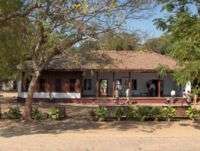Ashram


Traditionally, an ashram (or ashramam) is a spiritual hermitage or a monastery in Indian religions.[1][2] Today the term ashram often denotes a locus of Indian cultural activity such as yoga, music study or religious instruction, similar to a studio, yeshiva, iʿtikāf or dojo.
Etymology
The word ashram (also ashrama, spelled आश्रम in Sanskrit) comes from the Sanskrit root srama (श्रम) which means "to toil", the "a" prefix indicates the negative, therefore ashram means "not to toil".[3]
Overview

An ashram would traditionally, but not necessarily in contemporary times, be located far from human habitation, in forests or mountainous regions, amidst refreshing natural surroundings conducive to spiritual instruction and meditation. The residents of an ashram regularly performed spiritual and physical exercises, such as the various forms of yoga. Other sacrifices and penances, such as yajnas were also performed.[4] Many ashrams also served as gurukulas, residential schools for children under the guru-shishya tradition.
Sometimes, the goal of a pilgrimage to the ashram was not tranquility, but instruction in some art, especially warfare. In the Ramayana, the protagonist princes of ancient Ayodhya, Rama and Lakshmana, go to Vishvamitra's ashram to protect his yajnas from being defiled by emissary-demons of Ravana. After they prove their mettle, the princes receive martial instruction from the sage, especially in the use of divine weapons. In the Mahabharata, Krishna, in his youth, goes to the ashram of Sandipani to gain knowledge of both intellectual and spiritual matters.
Schools in Maharashtra
Residential schools, especially in the tribal areas of Maharashtra and elsewhere in India, are called ashram shala or ashram schools. One such school is the Lok Biradari Prakalp Ashram Shala.[5][6]


Christian ashrams
There are also Christian monasteries in India that are called ashrams and are run by the Saint Thomas Christians.
In the West
In recent years, a number of ashrams have been established outside of India. Typically, these ashrams are connected to Indian lineages. Sometimes they are headed by Indian spiritual teachers, and other times by Western spiritual teachers. Yoga is one of the main activities in the ashrams of the West.
Hindu ashram
There are number of Hindu ashrams in the US and Canada, called Retreat Centers. One of the well known ashram in Ontario, Canada is Vedic Ashram situated in Ingersoll.
References
- ↑ Swami Swahananda (1 January 1990). Monasteries in South Asia. Vedanta Press. pp. 92–. ISBN 978-0-87481-047-9.
- ↑ Mayeul de Dreuille (1999). "1 Hindu mansticism". From East to West: A History of Monasticism. Gracewing Publishing. pp. 3–27. ISBN 978-0-85244-464-1.
- ↑ S.S. Chandra; S.S. Chandra & Rajendra Kumar Sharma (1996). Philosophy of Education. Atlantic Publishers & Dist. pp. 173–. ISBN 978-81-7156-637-2.
- ↑ Gopal, Madan (1990). K.S. Gautam, ed. India through the ages. Publication Division, Ministry of Information and Broadcasting, Government of India. p. 70.
- ↑ Hetal Vyas (31 January 2009). "Shocked HC files suo-motu PIL over ashram rape and deaths". PuneMirror. Archived from the original on 2011-07-18. Retrieved 2009-03-17.
- ↑ "Lok Biradari Prakalp". Lok Biradari Prakalp. 2009. Retrieved 2009-03-17.
| Look up आश्रम in Wiktionary, the free dictionary. |